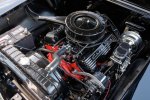...Ok, sort of new here so please be patient with my ignorance. I have a 1962 Impala bubble top. It has an almost stock 409 in it. it has a very very mild comp cam and the rest of the engine is bone original. it has the facorty aluminum"Winters intake". it hs been bored .030 over and uses "Ross" 9.1.1 Pistons. Fuel delivery is Holley Terminator X Stealth EFI. I have Dougs Stainless steel "Long Tube" Headers. The transmission is a prepared 4L60 shifted by the computer. The transmission is cooled by "Stand Alone", Derale fan assisted trans cooler, remotely fitted away from the radiator.
I have a 4 row "BE COOL" radiator ( vertical flow ) currently and have tried a very expensive U.S. Radiator, It is the "Optima' 4 row 3-way flow". My problem is that I can not get the engine to run cool enough that I feel confident in traffic. ( Yuma az.) summer temperatures average around 112. Sitting at a stop light in the afternoon with the A/C on is not an option, since it will get up to the 230's.
I have tried 3 radiators of different configurations with three different shrouds, to include the facory "Barrell type". I have an aluminum "High Flow" water pump. I run the engine at 12 degrees static timing. The computer maintains a 3.98-4.0 AFR ( Air Flow Ratio).
I have installed a 16" 3000 CFM electric fan. I have tried using a very agressive Motorhome 7 blade medal fan along with the electric fan and still it wont cool. I have installed two different manufactures Thermosats. 180, 190 and 160 to no availe. The engine has a total of 338 miles on it since overhauled and installed.
As a point of interest, using a "Thermal gun", the inlet temperature to the radiators is 190 and the outlet water temperature to the water pump is 184. When running the temperature up to 225 out of the engine, the temperature differental is 214.....Ugggh
While driving the car down the highway it will constantly climb slightly to the point that I have to turn off the A/C, and what ever the temperature is at that time it will not cool down, in fact it might even slightly increase a degree or two.
I have run out of ideas and pray that someone out there can enlighten me...Thank you for reading this.
Jim
I have a 4 row "BE COOL" radiator ( vertical flow ) currently and have tried a very expensive U.S. Radiator, It is the "Optima' 4 row 3-way flow". My problem is that I can not get the engine to run cool enough that I feel confident in traffic. ( Yuma az.) summer temperatures average around 112. Sitting at a stop light in the afternoon with the A/C on is not an option, since it will get up to the 230's.
I have tried 3 radiators of different configurations with three different shrouds, to include the facory "Barrell type". I have an aluminum "High Flow" water pump. I run the engine at 12 degrees static timing. The computer maintains a 3.98-4.0 AFR ( Air Flow Ratio).
I have installed a 16" 3000 CFM electric fan. I have tried using a very agressive Motorhome 7 blade medal fan along with the electric fan and still it wont cool. I have installed two different manufactures Thermosats. 180, 190 and 160 to no availe. The engine has a total of 338 miles on it since overhauled and installed.
As a point of interest, using a "Thermal gun", the inlet temperature to the radiators is 190 and the outlet water temperature to the water pump is 184. When running the temperature up to 225 out of the engine, the temperature differental is 214.....Ugggh
While driving the car down the highway it will constantly climb slightly to the point that I have to turn off the A/C, and what ever the temperature is at that time it will not cool down, in fact it might even slightly increase a degree or two.
I have run out of ideas and pray that someone out there can enlighten me...Thank you for reading this.
Jim


